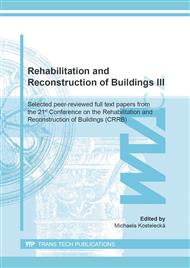p.39
p.45
p.51
p.57
p.65
p.70
p.79
p.86
p.92
The Curing of Concrete Samples with Water - Experimental Verification of the Concrete Properties
Abstract:
The process of producing a monolithic concrete structure on site is constructed out under different climatic conditions, which can often be unsuitable for setting and hardening of concrete. The necessary conditions for setting and hardening of concrete are ensured by various ways of its curing. In practice, concrete curing is carried out in most cases by water spraying. It is used mostly in reinforced concrete ceiling slabs, which are further discussed in the work. A common procedure is to cure the upper surface of reinforced concrete ceiling slabs. This work therefore deals with the effect of curing of a reinforced concrete slab, on its strength properties. Long-term curing would yield higher values of compressive strength, but it is also necessary to consider how effective it is. As a pilot research in this work is investigating the properties of concrete cubes in various curing. It further develops theoretical possibilities for continuing research.
Info:
Periodical:
Pages:
65-69
Citation:
Online since:
October 2020
Authors:
Price:
Сopyright:
© 2020 Trans Tech Publications Ltd. All Rights Reserved
Share:
Citation:


